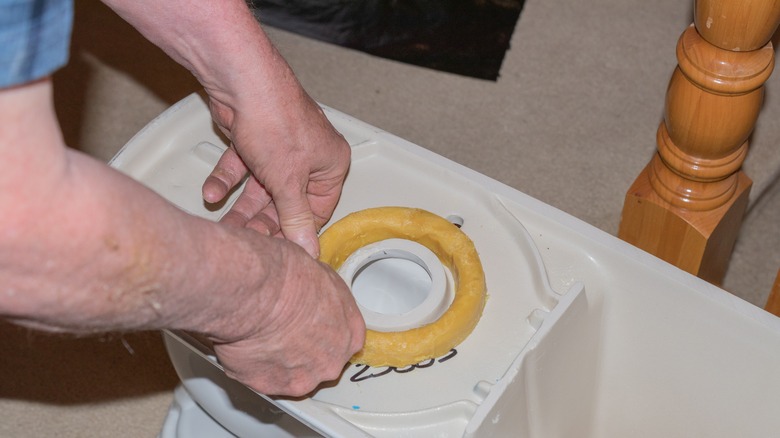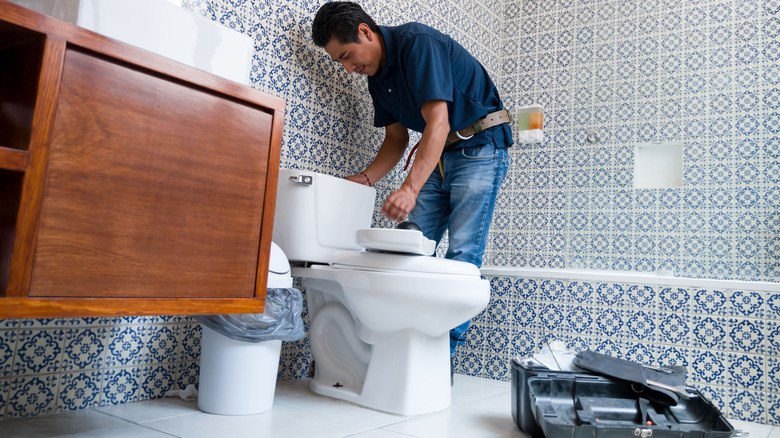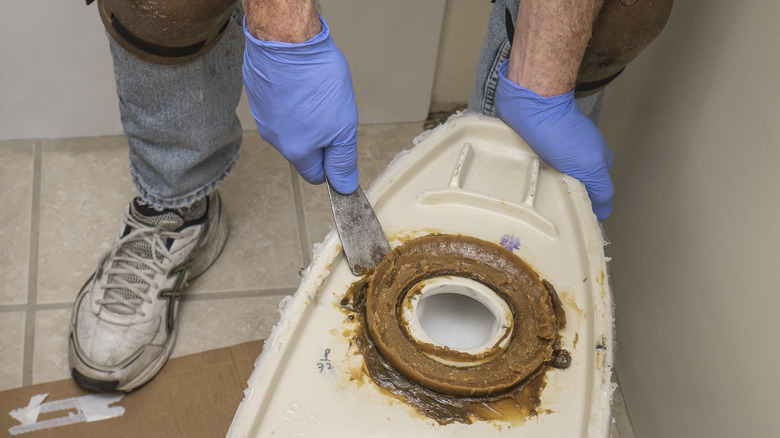Simple Tips For Replacing The Wax Ring On Your Toilet (And Why You'd Need To)
If you're accustomed to the no-compromises world of plumbing fittings, in which joints are sealed with molten metal or chemicals that fuse plastic pipes to each other, the toilet wax ring might seem a little strange. It seems more like a solution dreamed up by someone who meant to get back to it in the future: Just stick some wax in the gap for now, and we'll do something proper later. But these wax rings work, and given their job, it's a really good thing they do. The ring is compressed between the toilet and its floor flange to make the connection watertight and gas-tight. It's important to get the wax ring installation right, lest you find yourself in a never-ending cycle of lifting and lowering your toilet onto new wax rings. Be prepared to work very carefully when placing the toilet on the wax ring — or be prepared to get another ring.
Any time you replace or reinstall a toilet, the wax ring has to be replaced. In the case of a simple toilet upgrade, there might have been no problem to begin with, but perhaps you were experiencing a leak of liquids or gasses around the base of your toilet. This can happen for a number of reasons, such as a poor installation, a rocking or wobbling toilet that will eventually cause a wax seal to fail, or even the settling of your house, which can cause things to shift around.
Toilet installation tips
Installing a toilet is an awkward business. It seems so simple that it's natural to undertake it on your own. But soon you find yourself attempting to slowly lower a heavy toilet (they can weigh up to 120 pounds) onto two thin anchor bolts that won't stay in position. But you have to get it right, or you'll undermine the wax seal and have to start over. So bear in mind a few useful tips about installing your toilet smoothly the first time around.
The secret to a one-shot toilet installation is lowering the toilet straight down onto the wax ring one time. After the wax is compressed, lifting the toilet again will require a new ring, so work slowly and carefully. To make minor adjustments to the toilet's position, twist it gently, but don't rock it or apply unequal pressure to any side – a common mistake everyone makes when installing a toilet. Any side-to-side movement can cause the wax ring to shift or compress unevenly. It's helpful to have a second person guide the toilet onto the anchor bolts, if space allows. Marking the position of the toilet flange anchor bolts to the sides can be helpful in locating the bolts and aligning the toilet while you're lowering it. You can use painter's tape, pencil, chalk, etc. for these marks. Bracing yourself against a nearby wall can help to steady yourself during this process.
Some additional tips for working with wax rings
Wax rings themselves are simple mechanisms, but there are some ways you can give yourself an advantage when working with them. First, they are unbelievably sticky, which is great when contacting a toilet flange but less welcome on your hands, so wear disposable gloves when working with them. Or working with toilets, for that matter. Buy the right sized wax ring for your drain line -– usually 3 or 4 inches. They are not interchangeable. Some DIYers might advise you to stack multiple wax rings together, but avoid this temptation. The rings won't seal properly to each other and are more likely to create a leak than to prevent one. The ring will work best if it's installed when it's at least 70°F, but not more than 110°F.
Some wax ring kits come with a plastic toilet horn, which is helpful in guiding flushed water down the center of your drain. If your wax ring kit comes with replacement anchor bolts for your toilet, use them! These bolts undergo a lot of stress and often don't fare well when toilets are removed, so take the opportunity to install new ones. Finally, for regular and small gaps between toilet and flange, consider a wax-free seal. They are widely available and are more forgiving than wax rings. And while wax rings are better for irregular gaps, they are not repositionable and reusable the way wax-free seals are.


